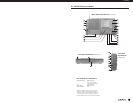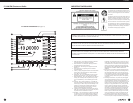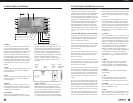
6
7
The etón E1 is a microprocessor controlled, synthesized,
world band receiver with continuous coverage capability
from 100 kHz through 30 MHz and from 76 MHz
through 108 MHz which includes the AM broadcast and
shortwave bands as well as the FM broadcast band.
The receiver offers excellent sensitivity, selectivity,
dynamic range, and features that permit easy tuning of
desired stations. Conveniently located front panel con-
trols allow for rapid operator programming and ease of
use.The units can be operated from either the supplied
ACADAPTER, an external 7 to 14 VDC source, or from
four "D" cell batteries (not supplied) for portable opera-
tion. A low battery voltage indication is displayed when
that condition exists.
Three electronically switched IF filters are provided to
provide optimum interference rejection for each mode.
The front panel dot matrix liquid crystal display provides
feedback of the current status of the receiver.The seven
digit frequency display provides resolution to 10 Hz in
theAM broadcast and Shortwave bands. Resolution to
20 kHz is displayed in the FM broadcast band.
Backlighting of the display is selectable by a “LIGHT”
key on top of the cabinet.To prolong battery life with
internal battery operation, the backlighting automatically
turns off after a short delay following a function change
or retuning of the receiver unless it is specifically locked
in the ON mode.
When the receiver is turned off, the display provides
either the Local time or Greenwich Mean time (GMT),
selectable in either the off or on state by the user.
Reception modes include Single Sideband (LSB & USB)
andAM in the Shortwave, MW (AM broadcast) and LW
bands. For the LW, Shortwave and MW bands, a selec-
table sideband synchronous detector (SYNC) allows for
enhanced AM reception by eliminating or reducing dis-
tortion due to fading signals or a strong adjacent signal.
During FM broadcast use, stereo reception is available
GENERAL DESCRIPTION
E
1 MANUAL
through the use of headphones, or by connecting the
line out jack to an external stereo system.
Other built-in reception aids include selectable slow,
fast, or automaticAGC time constant, scanning of mem-
ory channels, either by time or by carrier presence, pass-
band tuning and squelch as well as treble and bass con-
trols.Two independent, real time clocks provide Local or
GMT time selection.Also provided are a two event
timer, a SLEEP timer, and a SNOOZE mode.
A programmable memory area allows for 1700 indepen-
dent receiver set up memories. The first 500 of these
memory channels allow names to be attached to the
frequencies and modes stored.The remaining 1200
memory channels allow frequencies to be stored by
country.There are 111 country names factory stored in
this bank of memory with 10 memory channels available
per country and 90 memory channels remaining with no
country assigned.These country names can be modified
or added to by the user.These memories do not require
battery backup and are thus unaffected by power inter-
ruptions.
All parameters associated with a particular memory
channel are stored including the frequency, mode, band-
width, passband tuning setting, fast, slow, or automatic
AGC and synchronous detector state.These memory
channels may be accessed manually or through a time
scan with each channel monitored for a 5 second peri-
od, or carrier presence.
POWER SUPPLY
AC ADAPTER and EXTERNAL DC POWERING
The etón E1 receiver is supplied with an AC ADAPTER.
The AC ADAPTER is designed to be plugged into a wall
outlet that supplies AC power, or another source of exter-
nal filtered DC power between 7 and 12 VDC may be
used.
Connect the output connector of the AC adapter, or other
power source, to the 9 VDC, 1 amp connector on the side
of the receiver.
If batteries are installed and external power is lost, the
receiver will continue to operate on battery power even
with the DC plug inserted. If this occurs, the receiver will
alert the user with a POWER LOSS indication, and with a
POWER LOSS beep if the POWER LOSS beep feature is
enabled. More details concerning power loss can be
found on page 20, paragraph 27b.
TABLE OF CONTENTS continued
QUICK REFERENCE GUIDE p.48
GLOSSARY OF TERMS p.51
TROUBLESHOOTING p.52
SERVICE INFORMATION p.53
ONE YEAR LIMITED WARRANTY p.53
APPENDIX p.54
• UNDERSTANDING SHORTWAVE BANDS p.54
-WHAT IS SHORTWAVE?
- SOME BASIC RULES OF THUMB
-WHATARE BANDS?
-A HELPFUL ANALOGYABOUT BANDS
- DAY BANDS v s. NIGHTBANDS
- SUNSETAND SUNRISE
- DAYTIME LISTENING
- EVENING/NIGHT LISTENING
- SHORTWAVE DIRECTORY
- SHORTWAVE ANTENNAS
- FULL-SIZED PASSIVE SHORTWAVE ANTENNAS
-ACTIVE SHORTWAVEANTENNAS
- SHORTWAVE ANTENNAS FOR USEON BOATS
- LONG-WIRE SHORTWAVE ANTENNAS
-AM ANTENNAS
- FINDINGANTENNAS
-TIME STATIONS
- GETTING STARTEDW ITH SINGLE SIDEBAND (SSB)
-WEATHER FAX FREQUENCIES
- MORE INFORMATION ABOUTSSB
- MONTHLY MAGAZINESW ITH SSB RELATED INFO
-TIME STATIONS (not SSB)
• ETON E1 QUICK GUIDE p.58
- INTRODUCTION
- SET-UP INFORMATION
-TUNING-IN FM ANDMW STATIONS
- USING DIRECT FREQUENCY ENTRY
- USINGTHE SEEK FEATURE
- LISTENINGTO SHORTWAVE STATIONS
- CHOOSINGTHE BEST SHORTWAVE BAND
- GETTING INTO ASHORTWAVE BAND
-
TUNINGAROUND IN ASHORTWAVE BAND
-
STORING FREQUENCIES INTO MEMORY
-ACCESSING WHATYOU HAVE STORED INTO MEMORY
- DELETINGTHE CONTENTS OFA MEMORY
- SETTINGTHE CLOCKTOYOUR LOCALTIME
-
SETTINGTHE DISPLAY FOR LOCAL OR GMTTIME
- SETTINGTHE TIMER ASANALARM CLOCK
- USINGTIMER 1AS AWAKE-UP TIMER
- USINGTIMER 2AS A SLEEP TIMER
-TO ENABLE OR DISABLETHE TIMERS
SPECIFICATIONS p.62
BLOCK DIAGRAM p.64


















